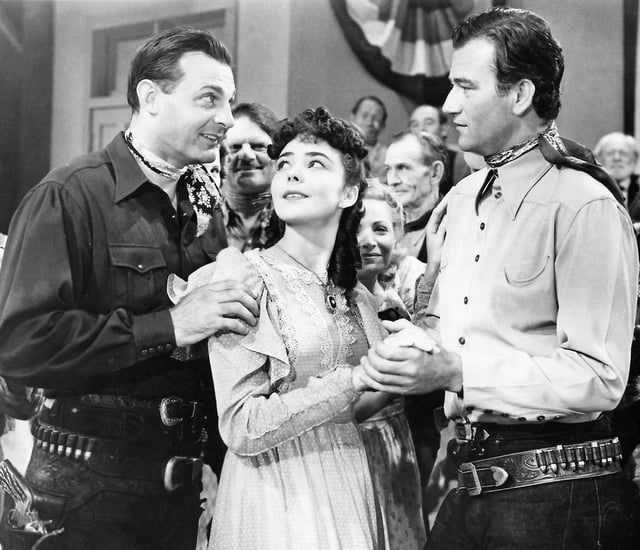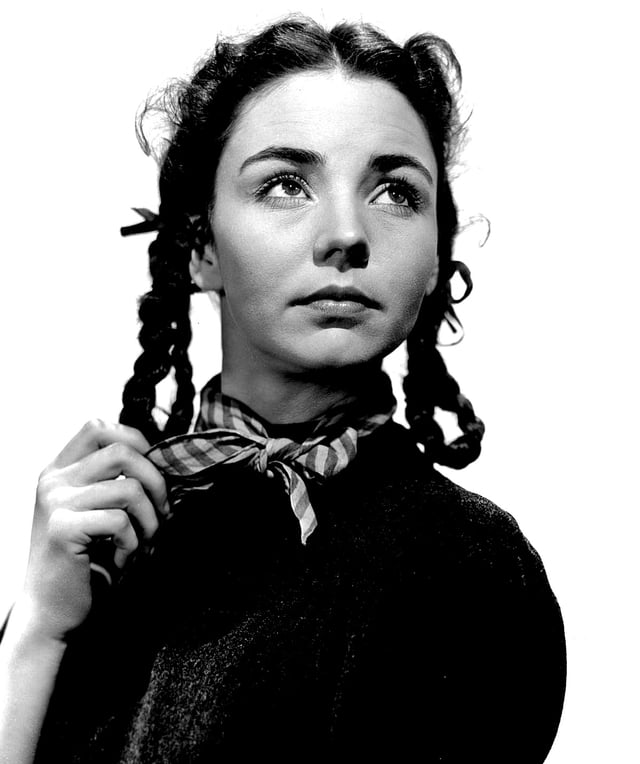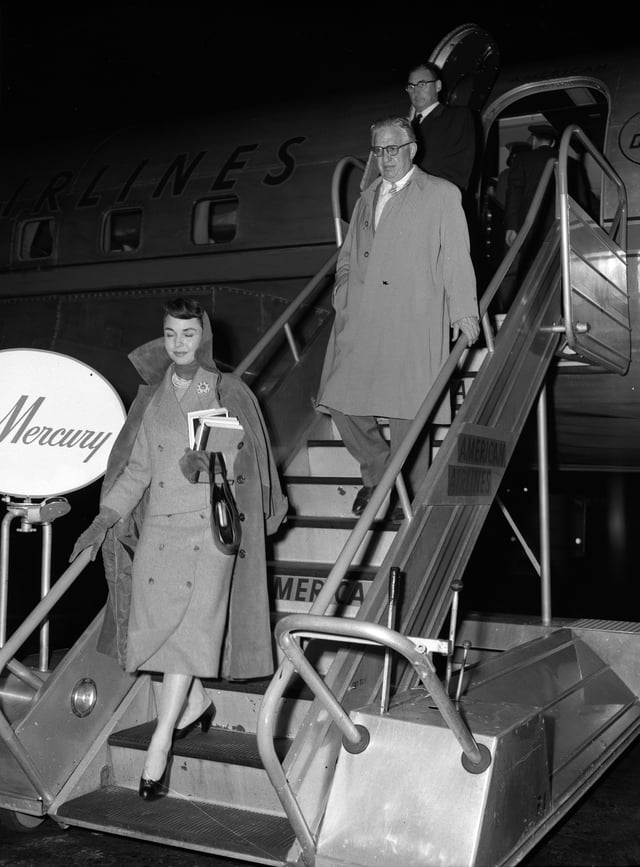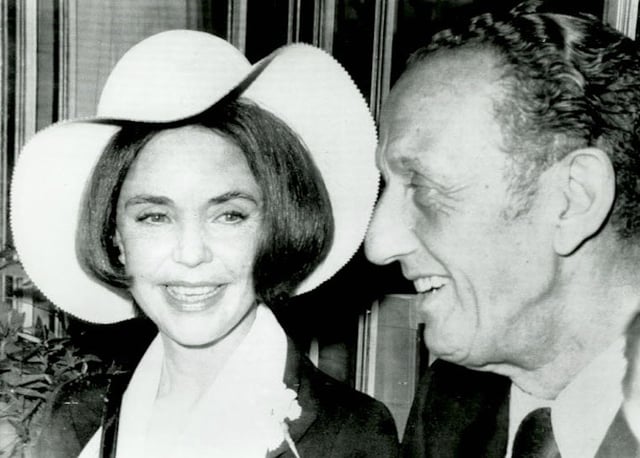Jennifer Jones

Jennifer Jones

Jennifer Jones | |
|---|---|
| Born | Phylis Lee Isley (1919-03-02)March 2, 1919 Tulsa, Oklahoma, U.S. |
| Died | December 17, 2009(2009-12-17)(aged 90) Malibu, California, U.S. |
| Resting place | Forest Lawn Memorial Park, Glendale, California, U.S. |
| Alma mater | Northwestern University American Academy of Dramatic Arts |
| Occupation | Actress, singer |
| Years active | 1939–1974 |
| Spouse(s) | Robert Walker (m. 1939;div. 1945) David O. Selznick (m. 1949; died 1965) Norton Simon (m. 1971; died 1993) |
| Children | 3, including Robert Walker Jr. |
Jennifer Jones (born Phylis Lee Isley; March 2, 1919 – December 17, 2009), also known as Jennifer Jones Simon, was an American actress and mental health advocate. Over the course of her career that spanned over five decades, she was nominated for the Oscar five times, including one win for Best Actress, as well as a Golden Globe Award win for Best Actress in a Drama. Jones is among the youngest actresses to receive an Academy Award, having won on her 25th birthday.
A native of Tulsa, Oklahoma, Jones worked as a model in her youth before transitioning to acting, appearing in two serial films in 1939. Her third role was a lead part as Bernadette Soubirous in The Song of Bernadette (1943), which earned her the Academy Award and Golden Globe for Best Actress that year. She went on to star in several films that garnered her significant critical acclaim and a further three Academy Award nominations in the early-1940s, including Since You Went Away (1944), Love Letters (1945), and Duel in the Sun (1946)
In 1949, Jones married film producer David O. Selznick, and appeared as the titular Madame Bovary in Vincente Minnelli's 1949 adaptation. She appeared in several films throughout the 1950s, including Ruby Gentry (1952), John Huston's adventure comedy Beat the Devil (1953), and Vittorio De Sica's drama Terminal Station (also 1953). Jones earned her fifth Academy Award nomination for her performance as a Eurasian doctor in Love is a Many-Splendored Thing (1955).
After Selznick's death in 1965, Jones married industrialist Norton Simon and went into semi-retirement. She made her final film appearance in The Towering Inferno (1974). Jones suffered from mental health problems during her life and survived a 1966 suicide attempt in which she jumped from a cliff in Malibu Beach. After her own daughter committed suicide in 1976, Jones became profoundly interested in mental health education. In 1980, she founded the Jennifer Jones Simon Foundation for Mental Health and Education. She spent the remainder of her life withdrawn from the public, residing in Malibu, California, where she died in 2009, aged 90.
Jennifer Jones | |
|---|---|
| Born | Phylis Lee Isley (1919-03-02)March 2, 1919 Tulsa, Oklahoma, U.S. |
| Died | December 17, 2009(2009-12-17)(aged 90) Malibu, California, U.S. |
| Resting place | Forest Lawn Memorial Park, Glendale, California, U.S. |
| Alma mater | Northwestern University American Academy of Dramatic Arts |
| Occupation | Actress, singer |
| Years active | 1939–1974 |
| Spouse(s) | Robert Walker (m. 1939;div. 1945) David O. Selznick (m. 1949; died 1965) Norton Simon (m. 1971; died 1993) |
| Children | 3, including Robert Walker Jr. |
Biography
1919–1939: Early life

Ray Corrigan, Jennifer Jones, and John Wayne in New Frontier (1939)
Jones was born Phylis Lee Isley[1] in Tulsa, Oklahoma on March 2, 1919, the daughter of Flora Mae (née Suber) and Phillip Ross Isley.[2] Her father was originally from Georgia, while her mother was a native of Sacramento, California.[2] An only child, Jones was raised Roman Catholic. Her parents, both aspiring stage actors, toured the Midwest in a traveling tent show that they owned and operated. Jones accompanied them, performing on occasion as part of the Isley Stock Company.[3]
In 1925, Jones enrolled at Edgemere Public School in Oklahoma City, then subsequently attended Monte Cassino, a Catholic girls school and junior college in Tulsa.[4] After graduating, she enrolled as a drama major at Northwestern University in Illinois, where she was a member of Kappa Alpha Theta sorority before transferring to the American Academy of Dramatic Arts in New York City in September, 1937.[5] It was there that she met and fell in love with fellow acting student Robert Walker, a native of Ogden, Utah.[5] The couple married on January 2, 1939.[6]
Jones and Walker returned to Tulsa for a 13-week radio program arranged by her father and then made their way to Hollywood. She landed two small roles, first in a 1939 John Wayne Western titled New Frontier, which she filmed in the summer of 1939 for Republic Pictures.[7] Her second project was the serial entitled Dick Tracy's G-Men (1939), also for Republic.[8] In both films, she was credited as Phylis Isley.[9] After having failed a screen test for Paramount Pictures, Jones became disenchanted with Hollywood and decided to return to New York City.[10]
1940–1948: Career beginnings

Jones as Bernadette Soubirous in The Song of Bernadette (1943)
Shortly after Jones married Walker, she gave birth to two sons: Robert Walker Jr. (b. 1940), and Michael Walker (1941–2007). While Walker found steady work in radio programs, Jones worked part-time modeling hats for the Powers Agency, as well as posing for Harper's Bazaar while looking for possible acting jobs.[11] When she learned of auditions for the lead role in Claudia, Rose Franken's hit play, in the summer of 1941, she presented herself to David O. Selznick's New York office but fled in tears after what she thought was a bad reading.[12] However, Selznick had overheard her audition and was impressed enough to have his secretary call her back. Following an interview, she was signed to a seven-year contract.[13]
She was carefully groomed for stardom and given a new name: Jennifer Jones. Director Henry King was impressed by her screen test as Bernadette Soubirous for The Song of Bernadette (1943) and she won the coveted role over hundreds of applicants.[14] In 1944, on her 25th birthday, Jones won the Academy Award for Best Actress for her performance as Bernadette Soubirous, her third screen role.[15]
Simultaneous to her rise to notoriety for The Song of Bernadette, Jones began an affair with producer Selznick. She separated from Walker in November 1943, co-starred with him in Since You Went Away (1944), and formally divorced him in June 1945.[16] For her performance in Since You Went Away, she was nominated for her second Academy Award, this time for Best Supporting Actress.[17] She earned a third successive Academy Award nomination for her performance opposite Joseph Cotten in the film noir Love Letters (1945).[18]
Jones's dark beauty and initial saintly image — as shown in her first starring role — was a stark contrast three years later when she was cast as a provocative bi-racial woman in Selznick's controversial Western Duel in the Sun (1946), in which she portrayed a Mestiza orphan in Texas who falls in love with an Anglo man (portrayed by Gregory Peck).[19] The same year, she starred as the title character in Ernst Lubitsch's romantic comedy Cluny Brown, playing a working-class English woman who falls in love just prior to World War II.[20] In 1947, she filmed Portrait of Jennie, a fantasy film released in 1948, based on the novella of the same name by Robert Nathan.[21] The film reunited her with co-star Cotten, who portrayed a painter who becomes obsessed with her character, the titular Jennie.[22] It was a commercial failure, grossing only $1.5 million in rentals against a $4 million budget.[23]
1949–1964: Marriage to Selznick

Jones and second husband David O. Selznick in 1957

Jones and Montgomery Clift in Terminal Station (1953)
Jones married Selznick at sea on July 13, 1949, en route to Europe, after having carried on a relationship for five years.[24] Over the following two decades, she would appear in numerous films he produced, and they established a working relationship.[25] The year they married, Jones starred opposite John Garfield in John Huston's adventure film We Were Strangers.[26] Bosley Crowther of The New York Times felt that Jones's performance was lacking, noting: "There is neither understanding nor passion in the stiff, frigid creature she achieves."[27] She was subsequently cast as the title character of Vincente Minnelli's Madame Bovary (1949), a role originally intended for Lana Turner, but that she had turned down.[28] Variety deemed the film "interesting to watch, but hard to feel," though it was noted that "Jones answers to every demand of direction and script."[29] In 1950, Jones starred in the Powell and Pressburger-directed fantasy Gone to Earth, portraying a superstitious gypsy woman in the English countryside.[30]
Next, Jones starred in William Wyler's drama Carrie (1952), opposite Laurence Olivier.[31] Crowther of The New York Times was unenthused by her performance, writing: "Mr. Olivier gives the film its closest contact with the book, while Miss Jones' soft, seraphic portrait of Carrie takes it furthest away."[32] Also in 1952, she co-starred with Charlton Heston in Ruby Gentry, playing a femme fatale in rural North Carolina who becomes embroiled in a murder conspiracy after marrying a local man.[33] The role had previously been offered to Joan Fontaine, who declined it as she felt she was "unsuited to play backwoods."[34] In their review, Variety deemed the film a "sordid drama [with] neither Jennifer Jones nor Charlton Heston gaining any sympathy in their characters."[35]
In 1953, Jones was cast opposite Montgomery Clift in Italian director Vittorio De Sica's Terminal Station (Italian: Stazione Termini), a Rome-set drama concerning a romance between an American woman and an Italian man.[36] The film, produced by Selznick, had a troubled production history, with Selznick and De Sica disputing over the screenplay and tone of the film.[37] Clift sided with De Sica, and reportedly called Selznick "an interfering fuck-face" on set.[38] Aside from the tensions between cast and crew, Jones herself was mourning the recent death of her first husband, Robert Walker, and also missed her two sons, who were staying in Switzerland during production.[39] Terminal Station was screened at the 1953 Cannes Film Festival,[40] and subsequently released in a heavily-truncated form in the United States, bearing the title Indiscretion of an American Wife.[41] Also in 1953, Jones re-teamed with director John Huston to star in his film Beat the Devil (1953), and adventure comedy co-starring Humphrey Bogart.[42] The film was a box-office flop and was critically panned upon release, leading even Bogart to distance himself from it.[42] However, it would undergo reevaluation in later years from such critics as Roger Ebert, who included it in his list of "Great Movies" and cited it as the first "camp" film.[43] In August 1954, Jones gave birth to her third child, daughter Mary Jennifer Selznick.[44]
Jones was subsequently cast as Eurasian doctor Han Suyin in the drama Love Is a Many-Splendored Thing (1955), a role that earned her her fifth Academy Award nomination.[45] Crowther of The New York Times lauded her performance as "lovely and intense. Her dark beauty reflects sunshine and sadness."[46] Next, she starred as a schoolteacher in Good Morning, Miss Dove (1955), opposite Robert Stack,[47] followed by a lead role opposite Gregory Peck in The Man in the Gray Flannel Suit, a drama about a World War II veteran.[48]
In 1957, she starred as the poet Elizabeth Barrett Browning in the historical drama The Barretts of Wimpole Street, based on the 1930 play by Rudolf Besier.[49] She followed this with a lead in the Ernest Hemingway adaptation A Farewell to Arms (1957), opposite Rock Hudson.[50] The film received mixed reviews,[51] with Variety noting that "the relationship between Rock Hudson and Jennifer Jones never takes on real dimensions."[52] Jones's next project, another literary adaptation (this time of F. Scott Fitzgerald), came five years later in 1962's Tender Is the Night, in which she portrayed the emotionally troubled Nicole Diver, who observes her husband's falling in love with another woman while in the south of France.[53]
1965–2009: Later life and activities

Jones with husband Norton Simon after their marriage, May 1971
Selznick died at age 63 on June 22, 1965, and after his death, Jones semi-retired from acting. Her first role in four years was a lead part in the British drama The Idol (1966), as the mother of a rebellious son in the Swinging Sixties London.[54] On November 9, 1967, the same day her close friend, Charles Bickford died of a blood infection, Jones attempted suicide by jumping from the base of a cliff overlooking Malibu Beach.[55] According to biographer Paul Green, it was news of Bickford's death that triggered Jones's suicide attempt.[55] She was hospitalized in a coma from the incident before eventually recovering.[56][57] She returned to film with Angel, Angel, Down We Go in 1969, about a teenage girl who uses her association with a rock band to manipulate her family.[58]
On May 29, 1971, Jones married her third husband, Norton Simon, a multi-millionaire industrialist, art collector and philanthropist from Portland, Oregon.[6] The marriage took place aboard a tugboat five miles off the English coast, and was conducted by Unitarian minister Eirion Phillips.[6] Years before, Simon had attempted to buy the portrait of her that was used in the film Portrait of Jennie; Simon later met Jones at a party hosted by fellow industrialist and art collector Walter Annenberg.[59] Her last big-screen appearance came in the smash-hit disaster film The Towering Inferno (1974), which concerned the burning of a San Francisco skyscraper.[60] Her performance as a doomed guest in the building earned her a Golden Globe nomination for Best Supporting Actress.[61] Early scenes in the film showed paintings lent to the production by the art gallery of Jones' husband Simon.[62]
Two years later, on May 11, 1976, Jones' 22-year-old daughter, Mary—then a student at Occidental College—committed suicide by jumping from the roof of a 20-floor hotel in downtown Los Angeles.[63] This led to Jones' subsequent interest in mental health issues. In 1979, with husband Simon (whose own son, Robert, committed suicide in 1969[64]), she founded the Jennifer Jones Simon Foundation For Mental Health and Education, which she ran until 2003.[65] One of Jones's primary goals with the Foundation was to de-stigmatize mental illness.[66] "I cringe when I admit I've been suicidal, had mental problems, but why should I?" Jones said in 1980. "I hope we can reeducate the world to see there's no more need for stigma in mental illness than there is for cancer."[66] At the time, she also divulged that she had been a patient of psychotherapy since age 24.[66]
Jones spent the remainder of her life outside of the public eye. Four years before the death of her husband Simon in June 1993, he resigned as President of Norton Simon Museum in Pasadena and Jennifer Jones Simon was appointed Chairman of the Board of Trustees, President and Executive Officer. In 1996, she began working with architect Frank Gehry and landscape designer Nancy Goslee Power on renovating the museum and gardens. She remained active as the director of the Norton Simon Museum until 2003, when she was given emeritus status.
Death

Jones' star on the Hollywood Walk of Fame at 6429 Hollywood Boulevard
Jones enjoyed a quiet retirement, living with her son Robert Walker Jr. and his family in Malibu for the last six years of her life. She granted no interviews and rarely appeared in public. Jones participated in Gregory Peck's AFI Life Achievement Award ceremony in 1989 and appeared at the 70th (1998) and 75th (2003) Academy Awards as part of the shows' tributes to past Oscar winners.
She died of natural causes on December 17, 2009, at age 90.[67] She was cremated and her ashes were interred with her second husband in the Selznick private room at the Forest Lawn Memorial Park in Glendale, California.
Public image
Jones suffered from shyness for much of her life, and avoided discussing her past and personal life with journalists.[1] She was also averse to discussing critical analysis of her work.[1] Public discussion of Jones's working relationship with her husband, David O. Selznick, has often overshadowed her career.[25] Biographer Paul Green contends that, while Selznick helped facilitate her career and seek roles for her, "Jones excelled because she not only possessed outstanding beauty but she also possessed genuine talent."[25]
Filmography
| Year | Title | Role | Notes |
|---|---|---|---|
| 1939 | New Frontier | Celia Braddock | as Phyllis Isley; film debut[68] |
| Dick Tracy's G-Men | Gwen Andrews | as Phyllis Isley; 15-chapter serial | |
| 1943 | The Song of Bernadette | Bernadette Soubirous | Academy Award for Best Actress Golden Globe Award for Best Actress – Motion Picture Drama Locarno International Film Festival - Best Actress |
| 1944 | Since You Went Away | Jane Deborah Hilton | Nominated — Academy Award for Best Supporting Actress |
| 1945 | Love Letters | Singleton / Victoria Morland | Nominated — Academy Award for Best Actress |
| 1946 | Cluny Brown | Cluny Brown | Locarno International Film Festival - Best Actress |
| Duel in the Sun | Pearl Chavez | Nominated — Academy Award for Best Actress | |
| 1948 | Portrait of Jennie | Jennie Appleton | |
| 1949 | We Were Strangers | China Valdés | |
| Madame Bovary | Emma Bovary | ||
| 1950 | Gone to Earth | Hazel Woodus | |
| 1952 | Carrie | Carrie Meeber | |
| Ruby Gentry | Ruby Gentry | ||
| 1953 | Terminal Station | Mary Forbes | Re-released as Indiscretion of an American Wife |
| Beat the Devil | Mrs. Gwendolen Chelm | ||
| 1955 | Love Is a Many-Splendored Thing | Dr. Han Suyin | Nominated - New York Film Critics Circle Award for Best Actress (3rd place) Nominated — Academy Award for Best Actress |
| Good Morning, Miss Dove | Miss Dove | ||
| 1956 | The Man in the Gray Flannel Suit | Betsy Rath | |
| 1957 | The Barretts of Wimpole Street | Elizabeth Barrett | |
| A Farewell to Arms | Catherine Barkley | ||
| 1962 | Tender Is the Night | Nicole Diver | |
| 1966 | The Idol | Carol | |
| 1969 | Angel, Angel, Down We Go | Astrid Steele | a.k.a. Cult of the Damned |
| 1974 | The Towering Inferno | Lisolette Mueller | Nominated — Golden Globe Award for Best Supporting Actress – Motion Picture (final film role) |
Awards and nominations
Academy Awards
| Year | Category | Work | Result |
|---|---|---|---|
| 1956 | Best Actress | Love Is a Many-Splendored Thing | Nominated |
| 1947 | Duel in the Sun | Nominated | |
| 1946 | Love Letters | Nominated | |
| 1945 | Best Supporting Actress | Since You Went Away | Nominated |
| 1944 | Best Actress | The Song of Bernadette | Won |
Golden Globe Awards
| Year | Category | Work | Result |
|---|---|---|---|
| 1975 | Best Supporting Actress in a Motion Picture | The Towering Inferno | Nominated |
| 1944 | Best Actress – Motion Picture Drama | The Song of Bernadette | Won |
See also
List of oldest and youngest Academy Award winners and nominees